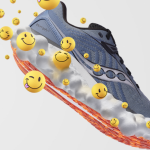A recent member survey from the Running Industry Association (RIA) found that while the run specialty channel has made progress in attracting the Gen X demographic, with Millennials not far behind, a significant opportunity remained to attract more Zoomers.
The findings mirror recent studies from Running USA and Adidas confirmed that “younger generations” take a more social and less competitive approach to running versus older generations.
In an RIA survey that asked run specialty stores what they would estimate to be the Top 5 age and gender demographics for the customers they reach, the answer was Millennials (age 25 to 40) and Gen X (age 43 to 58), while Gen Z (age 11 to 26) were under-indexed.
Overall, RIA reported that females aged 41 to 50, were the top demographic in a ten-year period, cited by 90 percent of run specialty retailers with the Top 5 age and gender demographics as follows:
- males, ages 41 to 50, 82 percent;
- females, ages 31 to 40, 78 percent;
- females, ages 51 to 60, 56 percent;
- males, ages 31 to 40, 54 percent; and
- males, ages 51-60, 34 percent.
In the Gen Z age range, only 22 percent of run specialty store respondents cited females, ages 20-to-30, among their Top 5 gender demographic, while 8 percent cited males, ages 20-to-30.
Running USA Sees Running Events At Risk
A recent study commissioned by Running USA, “Gen Z and Young Millennial Attitudes Toward Running,” concluded that the running events industry faced a “watershed moment” as older runners are aging out while fewer younger runners are participating.
The study also found that the percentage of runners in the 35-to-44 and 45-to-54 age groups had dropped significantly since 2015, while the share of race participants in the 25-to-34 age group grew only slightly.
“Now that Gen Z is coming of age and Millennials are aging, participating in running is threatening to trend downward,” the report reads. “The desire for exercise and motivations for being physically and mentally fit are changing drastically.”
USA Track & Field and World Athletics Adds Young Voices
RIA’s study was conducted in partnership with USA Track & Field and World Athletics, the global governing body for track and field. It surveyed 1,250 members of Gen Z (Americans ages 18-to-24) and 1,250 young Millennials (ages 25-to-30) in November 2022.
The key takeaway from the study was that fitness is not a motivation for running among the younger demographic. The data found that two-thirds of the respondents prefer walking for physical fitness and that Gen Z participates in fitness sports less than any other age group. “The primary fitness goal of the generation is not around health but friends, fun and purpose,” the report reads. “They are not as competitive as those preceding them.”
The top reason for the lack of physical activity was “not enough time.” Recommendations, given Gen Z’s social nature and reduced interest in fitness, include sharing participant or registrant stories, considering shorter events or ones with activities of various lengths and in messaging, emphasizing that “fit” does not equal “body type” and that everyone can run. The study states, “Events that focus on fun, friends and purpose will have better success with current and potential young runners.”
The report data also found that walking was the most popular physical activity for 18-to-30-year-olds. Two-thirds of respondents said they walk for physical fitness, including 74 percent of females and 59 percent of males. Nearly half of all respondents said they prefer to participate in runs/walks, compared to 25 percent who choose to participate in runs. Less than one-half (40 percent) responded that they get their physical activity at commercial fitness centers, and cost appears to be a factor when they do.
Advice included using “Run/Walk” or “Walk/Run” messaging instead of “Run” or “Race” to resonate more with the younger demographic. The study states, “They want to know that it’s OK to walk without having to ask. Remember, the primary fitness goal of the generation is not around health but friends, fun and purpose. They are not as competitive a generation as those preceding them.”
A third takeaway was that running events involving charities, specific sponsors/partners and invitations from neighbors were most likely to engage participants. Neither celebrities nor social media followers appeared to inspire race participation. Related recommendations included ensuring the cause is relevant to the area and/or audience. The study added, “Cause is king, but don’t assume you know how young people get their information.”
Finally, a fourth takeaway was that traditional marketing does not reach or resonate with the youngest runners. When Millennials entered adulthood, 95 percent learned about events through Facebook. Now, 88 percent of Gen-Z and 93 percent of Millennials watch YouTube. The study also called out the growing popularity of Instagram and TikTok.
Outreach recommendations included, “Establishing connectivity with Gen Z means going beyond Facebook and text. To create content on YouTube, Instagram and TikTok means reimagining how you interact with your audience. Compelling video and audio that connect with individuals is powerfully inspiring.”
Adidas Survey Finds Gen Z Has Different View Of Sport
A study conducted in 2022 by Adidas and the VMLY&R advertising agency found that Gen Z’s interests are less about competition and more about experience, fun and mental relaxation. The ability to adapt their pace to their capabilities and the absence of benchmarking against others is why an accompanying survey showed that 39 percent of Gen Z prefer to exercise alone.
The study found that the primary motivation to participate in sports was health and fitness (26 percent), followed by entertainment in free time (19 percent) and mental relaxation (17 percent). The study also found that among the reasons Gen Z likes running is “the feeling of freedom and freedom that not only running itself gives them but above all its temporal and spatial flexibility, financial availability and mental rest.”
For almost three-quarters (71 percent) of respondents, the study’s data showed that sports participation is also one of the key ways Gen Z shapes their individuality. Regular movement helps them gain greater self-confidence and courage, new contacts and experiences that they can apply in their personal or professional life.
Tomáš Sýkora, head of strategy at VMLY&R, said that for Gen Z, sports participation represents something much more open and diverse. “It has turned into something into which everyone can project their own values and attitudes and thus complete themselves, Sýkora said. “If only sports brands understand this fact, they will get a little closer to this very interesting target group. Purely physical activity has long since run out of steam.”
RIA Survey Identifies Opportunities Outside Runners
In RIA’s survey, the second in a three-part series exploring changes in the running consumer, other findings showed that run specialty stores could have a more significant opportunity to reach consumers outside runners.
Asked what were the Top 3 reasons that their customers gave for purchasing a pair of running shoes, the retailer’s top answer was running, cited by 96 percent, followed by walking, 72 percent; general fitness activities, 54; comfort, 42 percent; and casual wear, 16 percent.
Ranking minimally as a reason for shopping at a run specialty store was fashion, cited by 4 percent. Travel, medical referral, police, fire, nurse for work, and orthopedics were cited by 2 percent of retailers.
Asked about the Top 3 sports activities, other than running, that their customers told them they enjoy participating in, the No. 1 activity was walking, cited by 100 percent, followed by gym/weightlifting, 64 percent; hiking, 46 percent; pickleball, 26 percent; weight training, 22 percent; yoga/pilates, 12 percent, triathlon, 10 percent; and cycling, 8 percent.
Asked what the Top 3 weekly mileage goals were for customers who said they purchased shoes specifically to run, the No.1 answer was 10-to-20 miles, 82 percent; 20-to-30 miles, 66 percent; 5-to-10 miles, 66 percent; and 30-to-50 miles, 24 percent.
The RIA said in its analysis that the weekly mileage data “supports the fact that product solutions should continue to focus on fit and comfort as much as gait, given that short of a serious gait issue, most customers are probably not running enough to get injured, so their choices are much broader.”
Photo courtesy On
















